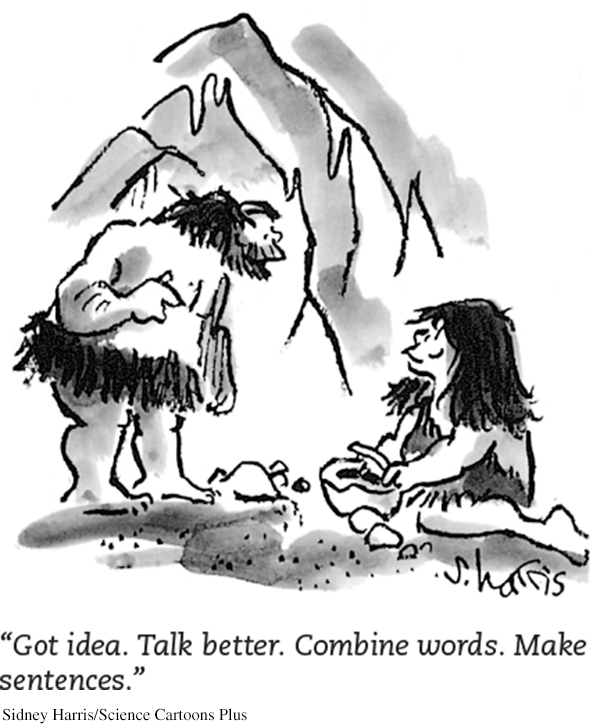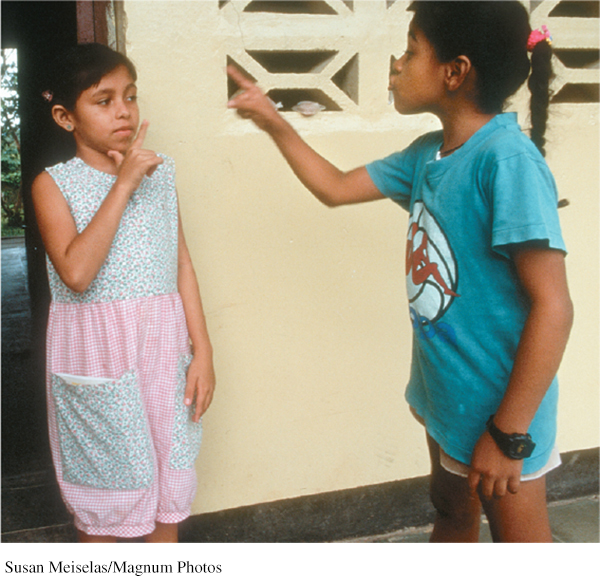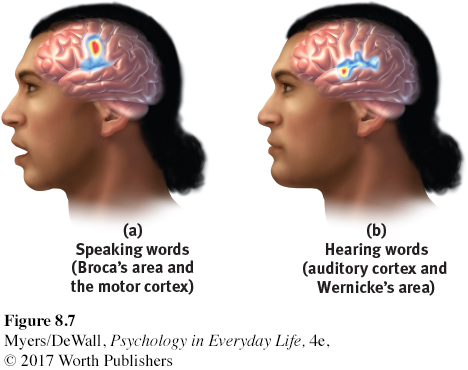8.2 Language
Imagine an alien species that could pass thoughts from one head to another merely by setting air molecules in motion between them. Actually, we are those creatures! When we speak, we send air-
language our spoken, written, or signed words, and the ways we combine them to communicate meaning.
Language is our spoken, written, or signed words, and the ways we meaningfully combine them. When I [DM] created this paragraph, my fingers on a keyboard triggered electronic signals that morphed into the squiggles in front of you. As you read these squiggles, they trigger nerve impulses that travel to areas of your brain that decode the meaning. Thanks to our shared language, information has just moved from my mind to yours. With language, we humans can transmit civilization’s knowledge from one generation to the next. Many animals know only what they see. Thanks to language, we know much that we’ve never seen and that our ancestors never knew.
232
Language also connects us. If you were able to keep only one cognitive ability, what would it be? Without sight or hearing, you could still have friends, family, and a job. But without language, could you have these things? “Language is so fundamental to our experience, so deeply a part of being human, that it’s hard to imagine life without it” (Boroditsky, 2009).
Language Development
LOQ 8-
Make a quick guess: How many words did you learn in your native language between your first birthday and your high school graduation? Although you use only 150 words for about half of what you say, you probably learned about 60,000 words (Bloom, 2000; McMurray, 2007). That averages (after age 2) nearly 3500 words each year, or nearly 10 each day! How you did it—
Could you even now state the rules of syntax (the correct way to string words together to form sentences) for the language(s) you speak fluently? Most of us cannot. Yet before you were able to add 2 + 2, you were creating your own original sentences and applying these rules. As a preschooler, your ability to understand and speak your language(s) was so great it would put to shame college students struggling to learn a new language.
We humans have an astonishing knack for language. Without blinking, we sample tens of thousands of words in our memory, effortlessly combine them with near-

When Do We Learn Language?
RECEPTIVE LANGUAGE Children’s language development moves from simplicity to complexity. Infants start without language (in fantis means “not speaking”). Yet by 4 months of age, babies can recognize differences in speech sounds (Stager & Werker, 1997). They can also read lips, preferring to look at a face that matches a sound. They can recognize that ah comes from wide open lips and ee from a mouth with corners pulled back (Kuhl & Meltzoff, 1982). This marks the beginning of the development of babies’ receptive language, their ability to understand what is said to and about them. At 7 months and beyond, babies grow in their power to break language they hear into individual words—
babbling stage beginning at about 4 months, the stage of speech development in which an infant spontaneously utters various sounds, many at first unrelated to the household language.
PRODUCTIVE LANGUAGE Babies’ productive language, their ability to produce words, matures after their receptive language. Before nurture molds their speech, nature allows a wide range of possible sounds in the babbling stage, around 4 months of age. In this stage, they seem to sample all the sounds they can make, such as ah-
By about 10 months old, infants’ babbling has changed so that a trained ear can identify the household language (de Boysson-
one-
Around their first birthday, most children enter the one-
two-
telegraphic speech early speech stage in which a child speaks in compressed sentences, like a telegram—
At about 18 months, children’s word learning explodes, jumping from about a word each week to a word each day. By their second birthday, most have entered the two-
| Month (approximate) | Stage |
|---|---|
| 4 | Babbles many speech sounds (“ah- |
| 10 | Babbling; resembles household language (“ma- |
| 12 | One- |
| 24 | Two- |
| 24+ | Rapid development into complete sentences |
233

Moving out of the two-
CRITICAL PERIODS What might happen if a child gets a late start on learning a particular language? This is not uncommon for children who have surgery to enable hearing, or who are adopted by a family in another country. For these late bloomers, language development follows the same sequence, though the pace is often faster (Ertmer et al., 2007; Snedeker et al., 2007). But there is a limit on how long language learning can be delayed.
Childhood seems to represent a critical (or “sensitive”) period for mastering certain aspects of language before the language-
grammar in a specific language, a system of rules that enables us to communicate with and understand others.
The impact of early experience is evident in language learning in children who have been deaf from birth. More than 90 percent of such children have parents who are not deaf and who do not use sign language. These children typically are not exposed to signed language during their early years. Those who learn to sign as teens or adults can master basic words and learn to order them. But they are not as fluent as native signers in using and understanding subtle differences in grammar (Newport, 1990).
After the language window closes, even learning a second language becomes more difficult. Have you learned a second language as an adult? If so, you almost certainly speak it with the accent of your first, and perhaps with imperfect grammar. This difficulty appeared in one study of Korean and Chinese immigrants (Johnson & Newport, 1991). Their task was to read 276 English sentences, such as “Yesterday the hunter shoots a deer,” and to decide whether each sentence was grammatically correct or incorrect. All had lived in the United States for approximately 10 years. Some had arrived as very young children, others as adults. As FIGURE 8.6 reveals, those who had learned their second language early learned it best. The older we are when moving to a new country, the harder it is to learn the new language and culture (Cheung et al., 2011; Hakuta et al., 2003). Cognitive psychologist Stephen Kosslyn (2008) summed it up nicely. “Children can learn multiple languages without an accent and with good grammar, if they are exposed to the language before puberty. But after puberty, it’s very difficult to learn a second language so well. Similarly, when I first went to Japan, I was told not even to bother trying to bow, that there were something like a dozen different bows and I was always going to ‘bow with an accent.’”

234
Retrieve + Remember
Question 8.3
•What is the difference between receptive and productive language, and when do children normally hit these milestones in language development?
ANSWER: Infants normally start developing receptive language skills (ability to understand what is said to and about them) around 4 months of age. Then, starting with babbling at 4 months and beyond, infants normally start building productive language skills (ability to produce sounds and eventually words).
Question 8.4
•Why is it so difficult to learn a new language in adulthood?
ANSWER: Our brain’s critical period for language learning is in childhood, when we can absorb language structure almost effortlessly. As we move past that stage in our brain’s development, our ability to learn a new language drops dramatically.
How Do We Learn Language?

The world’s 6000+ languages are structurally very diverse (Evans & Levinson, 2009). Linguist Noam Chomsky has argued that all languages nevertheless share some basic elements, which he calls a universal grammar. All human languages have nouns, verbs, and adjectives as basic building blocks. Moreover, said Chomsky, we humans are born with a built-
No matter what our language is, we start speaking mostly in nouns (kitty, da-
Retrieve + Remember
Question 8.5
•What was Noam Chomsky’s explanation of language development?
ANSWER: Chomsky maintained that all languages share a universal grammar, and humans are biologically predisposed to learn whatever language they experience.
The Brain and Language
LOQ 8-
We think of speaking and reading, or writing and reading, or singing and speaking as merely different examples of the same general ability—
235
Broca’s area controls language expression; an area of the frontal lobe, usually in the left hemisphere, that directs the muscle movements involved in speech.
Wernicke’s area controls language reception; a brain area involved in language comprehension and expression; usually in the left temporal lobe.
In 1865, French physician Paul Broca discovered that after damage to a specific area of the left frontal lobe (later called Broca’s area) a person would struggle to speak words, yet could often sing familiar songs with ease. A decade later, German investigator Carl Wernicke discovered that after damage to a specific area of the left temporal lobe (Wernicke’s area), people were unable to understand others’ words and could speak only meaningless words.
Today’s neuroscience has confirmed brain activity in Broca’s and Wernicke’s areas during language processing (FIGURE 8.7). But we now know that the brain processes language in other areas as well. Although you experience language as a single, unified stream, functional MRI (fMRI) scans would show that your brain is busily multitasking and networking. Different brain areas are activated by nouns and verbs (or objects and actions); by different vowels; by stories of visual versus motor experiences; by who spoke and what was said; and by many other stimuli (Perrachione et al., 2011; Shapiro et al., 2006; Speer et al., 2009). Moreover, if you’re lucky enough to be fluent in two languages, your hardworking brain assigns those two functions to two different sets of neural networks. One processes your native language, and the other handles your second language (Perani & Abutalebi, 2005).

 To review research on left-
To review research on left-
The big point to remember: In processing language, as in other forms of information processing, the brain operates by dividing its mental functions—
Retrieve + Remember
Question 8.6
•____ _______ is the part of the brain that, if damaged, might impair your ability to speak words. If you damage _____ _______, you might impair your ability to understand language.
ANSWERS: Broca’s area; Wernicke’s area
Thinking Without Language
LOQ 8-
To turn on the cold water in your bathroom, in which direction do you turn the handle? To answer, you probably thought not in words but in images—
Indeed, we often think in images. Mental practice relies on thinking in images. One year after placing second in a worldwide piano competition, pianist Liu Chi Kung was imprisoned during China’s cultural revolution. Soon after his release, after seven years without touching a piano, Liu was back on tour. The critics judged his playing to be better than ever, and his fans wondered how he had continued to develop without practice. “I did practice,” said Liu, “every day. I rehearsed every piece I had ever played, note by note, in my mind” (Garfield, 1986).
One experiment on the benefits of mental rehearsal observed the University of Tennessee women’s basketball team (Savoy & Beitel, 1996). Over 35 games, researchers tracked the team’s skill at shooting free throws following standard physical practice or mental practice. After physical practice, the team scored about 52 percent of their shots. After mental practice, that score rose to 65 percent. During mental practice, players had repeatedly imagined making free throws under various conditions, including being “trash-
236
Once you have learned a skill, even watching that skill happen triggers brain activity in the same areas that are active when you actually use the skill. As ballet dancers watch ballet videos, fMRI scans show their brain dancing along (Calvo-
Can mental rehearsal also help you reach your academic goals? Definitely! One study demonstrated this with two groups of introductory psychology students facing a midterm exam one week later (Taylor et al., 1998). (Students not engaged in any mental rehearsal formed a control group.) The first group spent five minutes each day imagining themselves scanning the posted grade list, seeing their A, beaming with joy, and feeling proud. This daily outcome simulation had little effect, adding only 2 points to their average exam score. The second group spent five minutes each day imagining themselves effectively studying—
 To experience your own thinking as (a) manipulating words and (b) manipulating images, see LaunchPad’s PsychSim 6: My Head Is Spinning!
To experience your own thinking as (a) manipulating words and (b) manipulating images, see LaunchPad’s PsychSim 6: My Head Is Spinning!
The point to remember: To benefit from your fantasy time, it’s better to imagine how to reach your goal than to focus on your desired destination.
Retrieve + Remember
Question 8.7
•What is mental practice, and how can it help you to prepare for an upcoming event?
ANSWER: Mental practice uses visual imagery to mentally rehearse future behaviors, activating some of the same brain areas used during the actual behaviors. Imagining the details of the process is more effective than visualizing only your end goal.
Do Other Species Have Language?
LOQ 8-
Humans have long and proudly claimed that language sets us above all other animals. “When we study human language, we are approaching what some might call the ‘human essence,’ the qualities of mind that are, so far as we know, unique [to humans]” (Chomsky, 1972). Is it true that humans, alone, have language?

Animals display great powers of understanding and communicating. Vervet monkeys sound different alarm cries for different predators: a barking call for a leopard, a cough for an eagle, and a chuttering for a snake. Hearing the leopard alarm, other vervets climb the nearest tree. Hearing the eagle alarm, they rush into the bushes. Hearing the snake chutter, they stand up and scan the ground (Byrne, 1991). To indicate complex alarms, monkeys may combine 6 different calls. Specific types of threats (eagle, leopard, falling tree, neighboring group) may trigger a 25-
Psychologists Allen Gardner and Beatrix Gardner (1969) were among the earliest to address this question in scientific experiments using sign language. In the late 1960s, they aroused enormous scientific and public interest with their work with Washoe, a young chimpanzee. After four years, Washoe could use 132 signs. By her life’s end in 2007, she was using 250 signs (Metzler, 2011; Sanz et al., 1998). One New York Times reporter, having learned sign language from his deaf parents, visited Washoe and exclaimed, “Suddenly I realized I was conversing with a member of another species in my native tongue.”
During the 1970s, more and more reports came in. Some chimpanzees were stringing signs together to form sentences. Washoe, for example, signed “You me go out, please.” Some word combinations seemed very creative—
But by the late 1970s, other psychologists were growing skeptical. Were the chimps language champs or were the researchers chumps? Consider the skeptics’ points:
Ape vocabularies and sentences are simple, rather like those of a 2-
year- old child. And apes gain their limited vocabularies only with great difficulty (Wynne, 2004, 2008). Speaking or signing children can easily soak up dozens of new words each week, and 60,000 by adulthood. Chimpanzees can make signs or push buttons in sequence to get a reward. But pigeons, too, can peck a sequence of keys to get grain (Straub et al., 1979). The apes’ signing might be nothing more than aping their trainers’ signs and learning that certain arm movements produce rewards (Terrace, 1979).
237
 IS THIS LANGUAGE? Chimpanzees’ ability to express themselves in American Sign Language raises questions about the very nature of language. Here, the trainer is asking, “What is this?” The sign in response is “Baby.” Does the response constitute language?Paul Fusco/Magnum Photos
IS THIS LANGUAGE? Chimpanzees’ ability to express themselves in American Sign Language raises questions about the very nature of language. Here, the trainer is asking, “What is this?” The sign in response is “Baby.” Does the response constitute language?Paul Fusco/Magnum PhotosStudies of perceptual set (see Chapter 5) show that when information is unclear, we tend to see what we want or expect to see. Interpreting chimpanzee signs as language may be little more than the trainers’ wishful thinking (Terrace, 1979). When Washoe signed water bird, she may have been separately naming water and bird.
“Give orange me give eat orange me eat orange . . .” is a far cry from the mastery of syntax in a 3-
year- old’s sentences (Anderson, 2004; Pinker, 1995). To the child, “You tickle” and “Tickle you” communicate different ideas. A chimpanzee, lacking human syntax, might use the same sequence of signs for both phrases.
Controversy can stimulate progress, as it did in this case. Studies of animal communication and the possibility of nonhuman language continued. An early and surprising finding was that Washoe’s adopted son, Loulis, had picked up 68 signs, simply by observing Washoe and three other language-
How should we interpret such studies? Are humans the only language-

One thing is certain. Studies of animal language and thinking have moved psychologists toward a greater appreciation of other species’ remarkable abilities (Friend, 2004; Rumbaugh & Washburn, 2003; Wilson et al., 2014). In the past, many psychologists doubted that other species could plan, form concepts, count, use tools, or show compassion (Thorpe, 1974). Today, thanks to animal researchers, we know better. Other animals exhibit insight, show family loyalty, communicate with one another, care for one another, and transmit cultural patterns across generations. Working out what this means for the moral rights of other animals is an unfinished task.
* * *
 For more case studies of intelligent communication and problem solving among orangutans, elephants, and killer whales, see LaunchPad’s 6-
For more case studies of intelligent communication and problem solving among orangutans, elephants, and killer whales, see LaunchPad’s 6-
Thinking about other species’ abilities brings us back to a question raised earlier in this chapter: How smart are we? Do we deserve the label Homo sapiens—
Retrieve + Remember
Question 8.8
•If your dog barks at a stranger at the door, does this qualify as language? What if the dog yips in a telltale way to let you know she needs to go out?
ANSWER: These are definitely communications. But if language consists of words and the grammatical rules we use to combine them to communicate meaning, few scientists would label a dog’s barking and yipping as language.